



Flocking to digital: the future of poultry technologies
Although touted as the world’s most efficient protein, poultry producers actually manage their flocks with very limited information.Growth in poultry farming has been relentless. In fact, despite the continued preference for pork in Asia, current growth means that global chicken meat consumption will exceed that of pork by 2022, making it the number one meat globally. Egg consumption continues to grow as well because eggs are inexpensive, mild-tasting and are easy to process and include in other foods. Universal acceptance by almost all cultures and all religions ensures that poultry will continue to prosper.
Although touted as the world’s most efficient protein, poultry producers actually manage their flocks with very limited information. Today, it takes 1.4 kilograms of feed to produce 1 kilogram of live-weight meat, and genetics offer the opportunity to reach a 1:1 ratio. Chicken producers know the birds’ weights when coming in and going out as well as average feed and water consumption. Egg farms at least have the daily data point of average egg production for a group of birds but managing for averages makes production inefficiencies inevitable.
What would make for better poultry production?
- From a production standpoint, individual real-time body weights, feed and water consumption.
- From a husbandry and welfare perspective, knowing the stress levels in the bird and bird comfort assessed through body temperatures and air quality factors, such as carbon dioxide and ammonia.
- From a disease management outlook, the ability to spot disease or find morbid birds before the entire flock is affected.
- From a food safety perspective, enhanced Salmonella, Campylobacter and E. coli detection.
- From a food processing perspective, increased yield.
In the next 30 years, we will see another 3 billion people inhabit the Earth, and the middle class of urban dwellers will continue to rise. Poultry farming must respond. Farmers must farm data, not just chickens, and in doing so, harness new digital technologies and information to improve efficiencies and respond to the growing requirements of proactively engaged consumers (“prosumers”). These eight digital technologies provide a useful framework to describe the plethora of novel technologies arriving in the marketplace that can help producers manage their flocks in a more efficient and sustainable way.
3D printing prosthetics
What is the realistic future of 3D printing in the poultry industry? Poultry operations would benefit from the on-site printing of plastic or metal parts when the ones on the farm require replacing. The University of Western Australia’s head of mechanical and chemical engineering, Tim Sercombe, has developed a printer that would use a metal powder that represents about 20 percent of the total cost of the part. Smaller part sizes might take a day to complete, but when compared to ordering and waiting for delivery of a part, the potential to save downtime on a farm could be considerable. Aurora Labs is focusing its efforts on agriculture, citing the opportunity for rural or remote farmers in Australia to come to their own rescue!
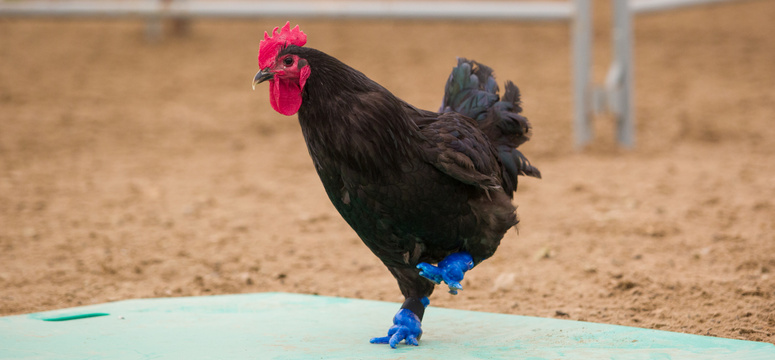
Foghorn's feet were 3D printed by researches at the University of Calgary
One of the more inventive ways in which 3D printing can affect the poultry industry is through life-saving techniques. Reproducing feet, legs and even beaks has already been applied for pet birds. One example includes researchers from the University of Calgary, who created prosthetic feet for Foghorn the rooster after he lost both of his feet, most likely an unfortunate result of severe frostbite. Then there’s Dudley the duck, who received an entire prosthetic leg (including the knee joint!) from the combined efforts of a 32-year-old mechanical engineer and architect who worked with Proto3000, a 3D printing company based out of Ontario. Imagine the opportunity for preserving high-value breeding stock such as parents, grandparents or great-grandparents, where continuing the genetic line is critical.
Robots doing the dirty work
One of the most practical applications of digital technology in the poultry industry is that of robots. There are a multitudinous number of repetitive tasks that robots could assist with. Poultry houses require nearly constant attention - cleaning and sanitising, collecting eggs and checking birds. This is time-consuming, monotonous work, but it would not bother a robot. Additionally, robots are more precise, thorough and honest about the work they do compared to their human counterparts. An article by Benjamin Ruiz also points out how robots can help from a human welfare standpoint.
Check out Wageningen University’s video demonstrating a robot that detects and picks up each egg with great care.
France-based Octopus Robots designs entirely autonomous robots to prevent and control disease and infection in poultry houses. The bots also evaluate environmental factors such as temperature, humidity, carbon dioxide, ammonia, sound and brightness.
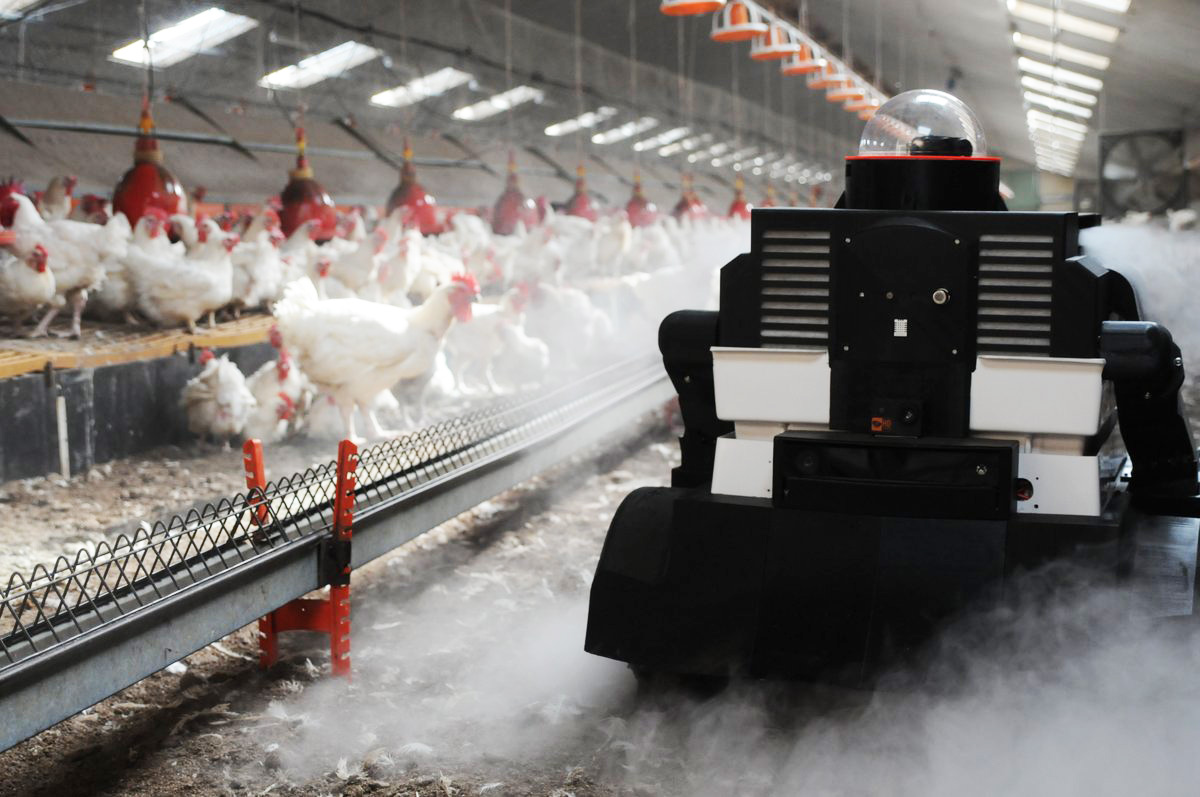
Another French robotic company, Tibot, explains that robots can discourage chickens from laying eggs on the floor and also keep the birds moving for an added health benefit. These attributes can result in cost-savings for producers in product and labor while appealing to welfare advocates.
For more specialised tasks, including feeding and monitoring, Metabolic Robots designed robotic feeders that can increase feed efficiencies, lower mortality rates and alert the producer of potential disease concerns. “Nanny robots” are used by Thailand’s Charoen Pokphand Group (CP Group) to maintain healthy flocks of around 3 million laying hens. If the robots detect an ill bird, humans are alerted and the bird is removed immediately. These automations will reduce outbreaks of bird flu and foodborne illnesses, improving the safety of the entire supply chain from producer to consumer. Also with safety in mind, Tyson recently announced the opening of its high-tech hatchery in Springdale, Arkansas. The operation spans 75,000 square feet (7,500 square miles) and hosts six robotic arms designed to replicate tasks that would otherwise result in worker fatigue.
Drones protecting the flock?
The opportunity for drones in chicken houses may seem a little farfetched. There is concern that the drone could make the flock nervous and cause undue stress. To this point, an experiment by Georgia Tech in 2015 showed the birds were not yet ready for this technology, compared to robots, which are probably better suited for indoor tasks anyway.
Free-range or yard-kept chickens and turkeys that roam fields freely would be a better application for drone technology, which could herd, protect and monitor them. Adaptation of avian species to drones would probably require training but will most likely succeed outdoors.
Sensors for individualised monitoring
Sensors probably represent the easiest of the eight technologies to implement. This is partly due to lower implementation costs, but also because the benefits are immediately recognised. Big Dutchman is one of the top names in modern poultry housing. Its DOL 53 is a sensor designed to measure ammonia, a common problem in many hen houses. Both SKOV and Filipino Poultry use sensors to regulate and control the climate in the house, including ventilation and temperature. Rotem’s sensor is designed for carbon dioxide monitoring, which can reduce the negative effects high carbon dioxide concentrations can have on layers and breeders, resulting in significant cost savings. Greengage has a unique lighting system using sensors and LED bulbs to create a consistent lighting environment that stimulates better growth efficiencies in birds and also reduces costs.
.jpg)
© Big Dutchman
From a wearable sensor perspective, researchers — and even farmers — could gain a lot of insight into the health and well-being of broilers, layers, turkeys and ducks. Fitted with RFID tags, poultry could then be observed in a more natural environment, giving researchers the opportunity to learn from the animals. This information could be evaluated to determine everything from natural behaviors to inefficiencies in diet, greatly increasing the opportunity to help with production efficiencies. Studies conducted at the University of Michigan have used sensors to analyze how chickens use space in their pens in order to better understand how to design non-cage systems for the comfort and well-being of the hens.
Artificial intelligence (AI) in processing
AI technologies have become the backbone of many other technologies. Robots, for example, use AI in the processing plant to improve efficiencies. Through a collaboration of efforts, iPoultry is a high-tech automated processing system first demonstrated at VIV Europe. Automating a procedure such as chicken deboning requires recognition of the shape and size of each chicken and individual adaptation. Artificial intelligence is the perfect technology for this application. Consider that a computer can analyze the difference in density and structure of meat versus bone, thereby making the most precise cut possible. This is a great example of combined technologies: robots perform the work that AI instructs them to do based on the data that sensors collect. The Gribbot by SINTEF is one such robot that can debone a chicken in two to three seconds, replacing up to 30 human operators! When combined with machine vision, companies like Gainco are also creating processors to achieve high productivity.
Companies such as Porphyrio, PMSI, Impex Barneveld and Intelia all use AI to monitor and control the environment of the house. Sensors collect the information, software tracks it and AI adjusts the conditions of the house or alerts the farmer if there is a potential issue, such as an ill bird. All this information can be transferred to the farmer’s iPad or smartphone. This is all done in real time and can curb concerns and small issues before they become disastrous to the entire flock. Aside from saving humans from doing these tasks, there are opportunities for cost savings, such as optimised feed consumption and climate control, increased production through healthier flocks because of cleaner water and better systems management. All of this information can be stored and analyzed to increase uniformity in production, which will ultimately increase performance and overall flock health.

Another AI application? Chicken translators! Many a poultry producer will attest that the sounds of the flock indicate health, comfort and overall well-being. By listening to and understanding the sounds of a healthy flock, producers can be tuned in to signals of distress and have a better chance of reducing stress or distress early on.
A form of AI, machine vision, has been used to grade eggs as well as determine defects such as cracking or internal blood spots. It can also be used in assessing infertility in incubation by scanning eggs and learning which are fertile and which are not. An algorithm is then created, enabling the machine to determine the accuracy of fertility by over 98 percent by day five of incubation.
A research study in Brazil used AI to better understand hen behavior and the difference in interactions when under thermal stress versus a comfortable environment. Specifically, they tapped into an area of research known as artificial neural networks, which makes it possible to “teach” computers how to do tasks using visual references and understand patterns. This was important because it reduced the chances that a researcher’s presence would alter the hen’s behavior, removed any subjectivity or misconception from the researcher’s standpoint, and allowed for a more precise calculation of the overall well-being of the hens.
This technology has allowed a significant challenge within the layer industry to be overcome. Layers, of course, are designed to produce eggs for consumption. To replace laying hens, farmers have to incubate some eggs, but they cannot tell until they are hatched which are male and which are female. The ability to sex the eggs was the undertaking of Vital Farms which has teamed up with Israeli technology company Novatrans to create Ovabrite. Using terahertz spectroscopy, the system can identify male eggs immediately after laying and sell them as unfertilised eggs for the farmer, allowing for significant cost savings within the layer industry.
Augmented reality helping the consumer
Augmented (or enhanced) reality is the ability to see things that the human eye cannot, using the non-visible spectrums of light, or to overlay information, including data interpretation, alongside what the person sees. The possible uses of the technology are wide-ranging, but so far, there are a few examples of real commercial applications.
Georgia Tech had a student project in which it investigated the use of AR in the processing plant. The application of AR allows trimmers in factories to see how to cut the chicken carcass and accurately remove defective parts of the meat. Two methods are being tried. One is using a head-mounted display in which the trimmer could see a graphical overlay on each bird indicating the best location for cutting. Alternatively, the project also tested a laser scanner that was mounted near the processing line and indicated directly onto each bird where to make the cuts. The latter was generally considered more cost-effective, as all workers could use the same equipment.
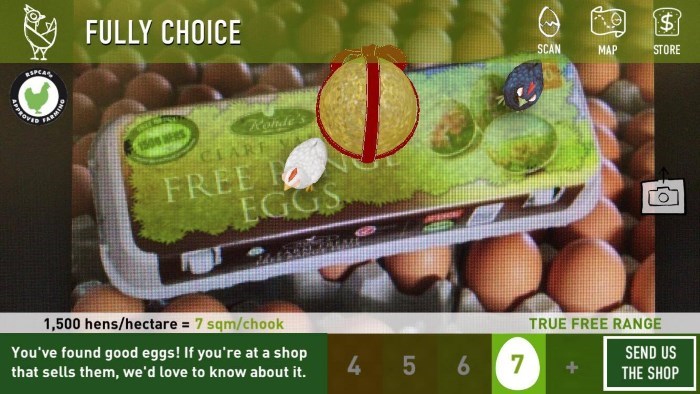
Apart from the benefits for farmers or processors, consumers may be the key to implementation. Transparency is becoming critical, as is having the ability to know where and how food is produced. Australian-based CHOICE offers all iPhone and Android users a free app that allows consumers to scan a code on the egg carton and download detailed information on where the eggs are from and information relating to their welfare conditions.
Virtual reality (VR) training in production
The most obvious application for VR in the poultry industry is training, particularly processing. It could teach line workers in the processing plant the ideal way to trim meat from birds. Applied to free-range layer houses, it could teach employees how to walk through the house without frightening the birds, find errant eggs and check on hens. An example of VR is how McDonald’s has teamed up with The Lakes Free Range Egg Company to give customers an immersive virtual tour of the farm’s hen houses, ranges and pack houses. This technology is, however, expensive, and implementation is likely to be slow.
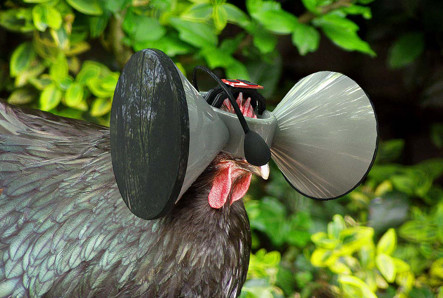
Another eccentric option is to give the virtual reality experience to the chickens. Created by professor Austin Stewart at the University of Iowa, Second Livestock is a conceptual company that allows chickens to enjoy the free-range experience while remaining contained within the safety of the poultry house. The idea is that chickens are equipped with a virtual headset and see through a screen projection using goggles. In this way, chickens can be raised anywhere, even in urban areas, and feel the freedom of their virtual world, free from predators. While this company may not actually be producing these products, it is important to recognise that the technology is there and is on its way to becoming increasingly more affordable.
Blockchain in production safety
Blockchain’s opportunity in the poultry industry is its ability to resolve food safety and transparency issues. Walmart, Unilever, Nestlé and other food giants are working with IBM using blockchain technology to secure digital records and monitor supply chain management, ensuring traceability of the poultry products sold in stores. Blockchain can be used to monitor all aspects of the food supply chain, from farmers and producers to processors and distributors. This is Walmart’s third experiment with blockchain and seeing the increasing interest of other large food conglomerates demonstrates the unique capabilities of this technology.
Recently, Cargill announced it would enable customers to trace their Thanksgiving turkey back to its farm of origin. Blockchain technology is what makes this possible. Consumers can enter a code from the package onto the company's website and learn where the turkey was bred and grown. This is a big step toward offering traceability and understanding where food comes from, something that is becoming of increasing concern for consumers.
ZhongAn Technology has launched a technology incubator to develop blockchain technologies, citing that there is an expectation of specific applications within the poultry industry. The Chinese consume about 5 billion chickens a year but prefer dark meat rather than the breast meat favored by American consumers. Recently, the country has been allowed to export cooked chicken to the United States, and blockchain could be a way to alleviate any concerns about sourcing and production methods, eventually opening the way for raw exports.
Internet of things (IoT)
The internet of things is listed separately from the other eight technologies because it is the technology that connects all the others. For example, ZhongAn is working to make chicken production safer and will utilise a collaboration with Wopu, a company that specialises in the internet of things. IoT connects many of the sensors in a hen house to a smartphone, iPad or other devices, which is the case with SmartPoultry.
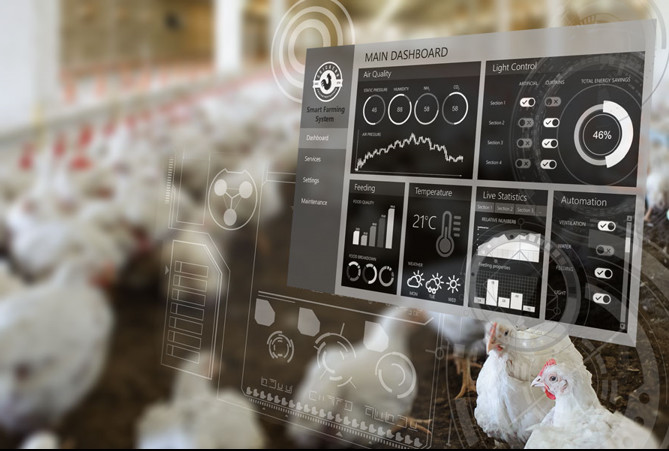
A paper by Rupali Bhagwan Mahale gives detailed insight into the applications of IoT in farm monitoring with a focus on the poultry industry. IoT can be incorporated at a very basic level, despite the complexity of the concept. My Connected Coop is a Kentucky-based venture created by Greg Cullen. The system allows even small home-grown and backyard chicken farmers to utilise this technology to raise their chickens easily and remotely using their mobile phones.
LX IoT Cores and Prognostix both offer technologies for improved efficiencies within the poultry sector through the use of combined sensor applications using cloud-based technologies and smart farming applications. M-TechSystems offers a software package to track and trace all elements of the farm, including information gathered from sensors, but also potentially from various sources, from robots to veterinary activity and upstream supplier information. This overall management of the entire chain offers incredible advancements to traceability, which is becoming increasingly important to all food production worldwide. Cargill’s TechBro Flex takes a producer’s own data and creates predictive analytic options, allowing the customer to choose their path based on a choice of strategic scenarios.
The Big Data advantage
As we can collect more information on animals including the bacteria in their digestive tract and how they respond to nutrition at the gene level, it becomes clear that farmers are learning how to manage vast amounts of data as much as they previously understood how to manage their animals. ‘Farming the data’ to predict an individual animal’s growth requires the ability to interpret ‘Big data’. Alltech has been creating complex algorithms to interpret information they are collecting of the microbiome, nutrigenomics and track pathogens, such as campylobacter or antibiotic resistant bacteria. While nutrigenomics allows us to generate information to feed the animal precisely, and DNA profiling to know exactly what specific bacteria are present. Without powerful data analysis there is no way to take advantage of this.
It is estimated that the world poultry production will increase 120 percent from 2010 to 2050. In order to meet this demand, feed conversion ratios and other production efficiencies must continue to improve. The incorporation of digital technologies, such as those listed above, will greatly aid in these efficiencies and help poultry producers to rise to the demands and meet the increasing needs of a global population.
The framework for these eight technologies was first proposed in a PwC article. Mr Connolly has also written variations on horses, pets and aquaculture.
Mr Connolly extends a great many thanks to Douglas Solis and Alexa Potocki for their contributions.
ONE: The Alltech Ideas Conference
New technologies including everything from blockchain to nutrigenomics are the focus at ONE: The Alltech Ideas Conference. Speakers include former GE CEO Jack Welch, Professor Robert Wolcott from the Kellogg's School of Management and CRISPR expert Dr Randolphe Barrangou. Over 4000 attendees and 70 speakers will cover business, technologies, innovation and science allowing for many opportunities for learning and some really interesting conversations!









